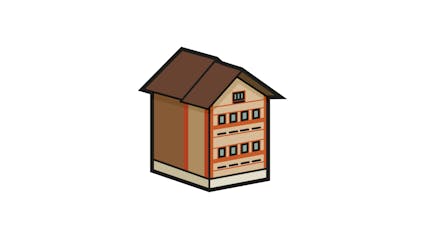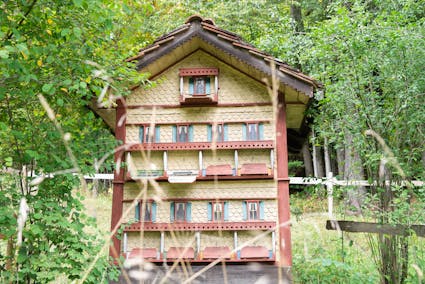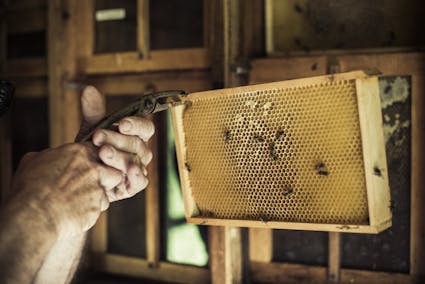383 – Apiary from Gwatt, Berne, around 1900
The apiary or bee house from a farm in Gwatt on the Lake of Thun is a miniature house.

Dollhouse for bees
There are model representations of almost everything; people apparently like miniaturisation. This apiary or bee house from a farm in Gwatt on the Lake of Thun is a miniature house: cute tile roof, barge boards along the eaves with a decorative saw-tooth fringe, little yellow shingles, holes for the bees formed like doll houses, painted-on windows and curtains, free-standing columns – this is a display facade with trompe-l’oeil painting which the farmer afforded himself. His nine bee swarms lived in contemporary fashion in the style of a charming chalet.

At home under a roof
The smaller building at the front with the bee holes faces the sun. The later addition at the back is a workspace for the beekeeper: here he can open the hives, inspect the honey, extract full combs and install empty ones, observe the health of the bees and nourish them for the winter with feed solutions. The beekeeping equipment is also stored here. Larger bee houses may have a centrifuge here for extracting honey from the combs. The house protects the bees from the weather and from enemies like ants, while it makes the beekeeper’s work easier.

Productive Patriots
Bee houses can be simple wooden huts. Some look like a shed, like the one from Mettmenstetten (614). More often, however, they are carefully decorated with fretwork and painting. Sometimes the urge to be decorative took the upper hand and led to miniature palaces like this one from Gwatt (383).
In the 19th century farmers tried to increase productivity in all branches of agriculture; beekeeping played its part. The introduction of fruit orchards required carefully planned pollination by bees.
Both builders and beekeepers were no less industrious than the bees themselves, which were a prime example of the busy activity and the patriotic fervour of the citizenry. The exemplary bee swarms, symbols of work and ethics, of cooperation and striving for a common goal, found their architectural fatherland in the style of the Swiss chalet.
Ballenberg
Swiss Open-Air Museum
Museumsstrasse 100
CH-3858 Hofstetten bei Brienz
Opening hours
11 April to 27 October 2024
10 am to 5 pm daily